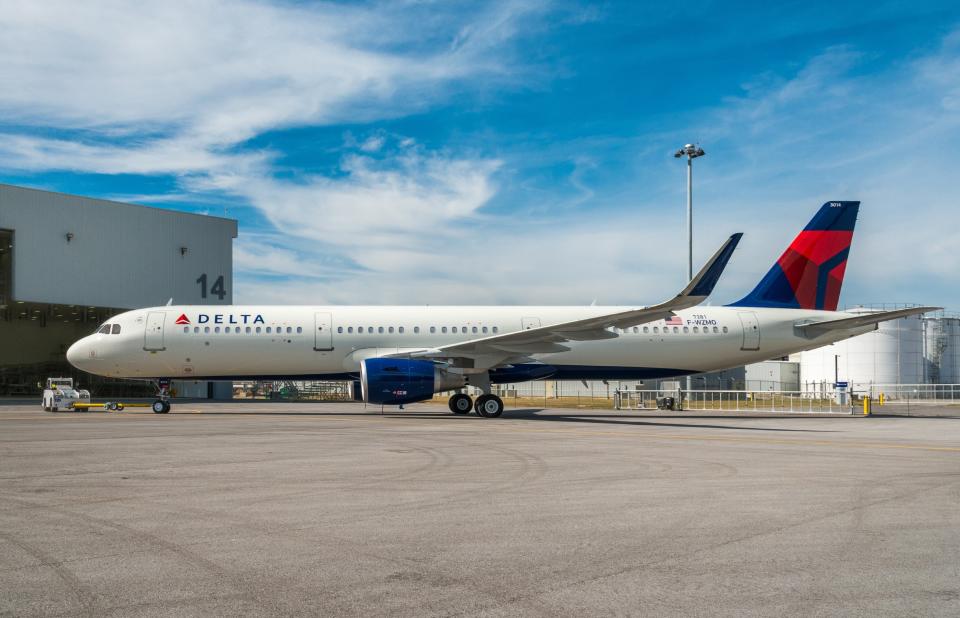Delta Air Lines Profit Soars on Strong Revenue Growth
Last week, Delta Air Lines (NYSE: DAL) raised its guidance for the second quarter. The airline giant said that revenue per available seat mile (RASM) had increased about 3.5% in the quarter, due to strong demand, reaching the high end of its initial 1.5% to 3.5% guidance range. As a result, Delta boosted its earnings-per-share forecast to the upper third of its previous range of $2.05 to $2.35.
On Thursday, the carrier reported its full results for the second quarter, and they were even better than expected. Delta also provided a solid forecast for the third quarter.
Unit revenue growth accelerates
In the first quarter of 2019, Delta Air Lines' adjusted RASM -- which excludes refinery product sales -- rose 2.4%, contributing to a 7.5% increase in adjusted total revenue. This surpassed management's forecast for the quarter.
Revenue growth accelerated in the second quarter. RASM jumped 3.8% to 17.42 cents, while total revenue surged 8.7% to $12.5 billion. (Both figures are again adjusted to exclude refinery product sales.)
Delta's revenue growth was particularly strong in the domestic market, as Delta capitalized on capacity declines at American Airlines and Southwest Airlines related to the Boeing 737 MAX grounding. Domestic passenger revenue rose 8.8% on a 3.6% increase in passenger revenue per available seat mile (PRASM). Passenger revenue rose a little more than 5% on international routes, with PRASM positive in the transatlantic and Latin America regions but down 5.9% year over year in the transpacific market.

Delta posted strong revenue growth last quarter, particularly in the U.S. Image source: Delta Air Lines.
Solid cost performance continues
In the first quarter, Delta Air Lines managed to reduce its adjusted nonfuel unit costs 0.2% year over year. This enabled it to post a stellar 28% increase in adjusted EPS.
Delta wasn't able to repeat that performance last quarter, as adjusted nonfuel unit costs rose 1.4%. Nevertheless, this kept the carrier on track to achieve its goal of 1% nonfuel unit cost growth for the full year. Furthermore, a $60 million increase in noncash depreciation expense (related to the company's decision to accelerate the retirement of its aging MD-90 fleet from 2024 to 2022) drove about half of the nonfuel unit cost increase.
On the other hand, year-over-year fuel cost trends improved last quarter. Delta paid $2.05 per gallon for jet fuel in the first quarter, up from $2.01 per gallon a year earlier. By contrast, Delta paid $2.08 per gallon for fuel in the second quarter, up slightly from the first quarter but down from $2.17 per gallon in Q2 2018. Delta earned a $37 million profit at its Trainer refinery last quarter, which helped to lower its fuel costs, and the refinery is likely to become even more profitable.
The combination of strong revenue growth and solid cost performance enabled Delta to report another quarter of rapid earnings growth. Adjusted EPS surged 32% to $2.35 last quarter, hitting the high end of Delta's guidance range and beating the average analyst estimate of $2.25.
Delta raises its profit outlook
For the third quarter, Delta expects RASM to rise 1.5% to 3.5%. This would represent a modest slowdown compared to last quarter. Meanwhile, Delta's outlook calls for a 1% to 2% increase in nonfuel unit costs. Fuel prices are projected to average between $1.95 per gallon and $2.15 per gallon, down from $2.22 per gallon a year ago.
All in all, this sets Delta up for another quarter of margin expansion and stellar EPS growth. This gave management the confidence to raise its full-year EPS forecast to a range of $6.75 to $7.25, compared to the original range of $6.00 to $7.00. For comparison, adjusted EPS came in at $5.65 last year.
Delta Air Lines stock moved higher following the earnings report, surpassing the $60 mark for the first time since last fall. Yet the shares still trade for less than nine times Delta's projected 2019 EPS, even though the company has ample earnings growth potential for 2020 and beyond. This suggests that there could still be plenty of upside left in Delta stock for patient investors.
More From The Motley Fool
Adam Levine-Weinberg owns shares of Delta Air Lines and Southwest Airlines and is long January 2020 $20 calls on American Airlines Group. The Motley Fool owns shares of and recommends Delta Air Lines and Southwest Airlines. The Motley Fool has a disclosure policy.

 Yahoo Finance
Yahoo Finance 